|
|
|
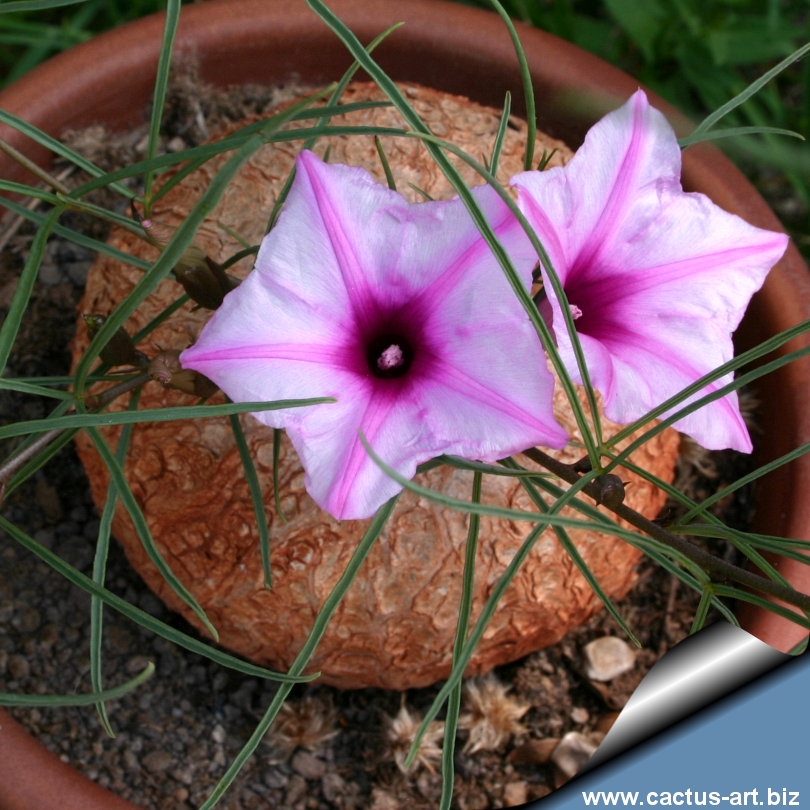
Ipomoea bolusiana is highly esteemed
by caudex and cactus growers for the beautiful flamboyant flowers that
are up to 4-7cm long, pink with deeper purple or magenta centres. The
leaves are cut into three lobes but the lobes are only 3 mm or so wide.
|
|
Description: Perennial
dwarf shrub,
glabrous with caudiciform rootstock.
Caudex: This plant has a thick tuberous, above-ground subglobose
or somewhat fusiform root-stock, 520 cm. in diam.
Stems: One or several, erect or
prostrate, woody at the base,
glabrous,
terete, usually slender. Length 0.2 - 3 m
Leaves: Widely spaced, narrow, covered in fine silver hairs. Leaf lamina
palmately 39 sect, with very narrow, linear or filiform segments 2070
Χ 0,54 (10) mm., sometimes somewhat
pinnate to distinctly pinnate, if 3
terminal segments are partly fused to form a common
rachis, or entire,
linear, sometimes linear spathulate, 410 (15) Χ 0,20,4 (0,7) cm.;
petioles of dissected leaves up to about 2 cm. long, of simple leaves
sometimes inconspicuous because the leaf is much narrowed at the base.
Flowers: Axillary, flamboyant, 4-7cm long (and 4-5cm wide)
funnel-shaped of soft to mid-pink with deeper purple or magenta centres
(Rare white forms are reported). Peduncle very short, rarely up to 6 cm.
long; pedicels very short, thickened, rarely up to 15 mm. long;
bracteoles, small, lanceolate, often deciduous. Sepals ovate-lanceolate,
lanceolate or oblong-lanceolate, sometimes ovate or elliptic, acute or
acuminate, 816 mm. long, glabrous. Corolla funnel-shaped, magenta-pink,
mauve or rosy-purple, darker in the centre, very rarely reported to be
white, 47,5 cm. long and 46 cm. in diam.
Fruit: Capsule subglobose-conical, apiculate by the style-base,
glabrous.
Seeds: covered with long shiny fawn hairs.
|
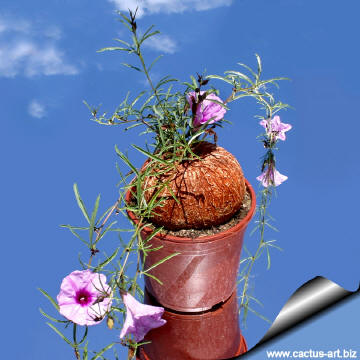 |
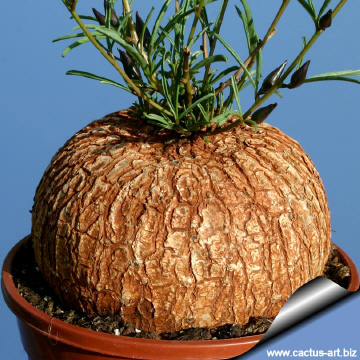 |
|
This is a spectacular species which forms a round decorative caudex from
which it then produces one or more trailing stems. |
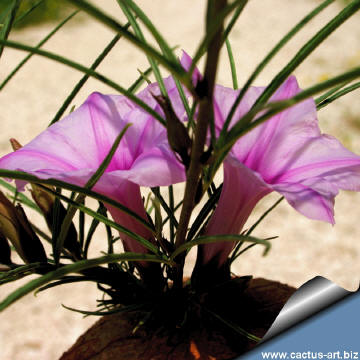 |
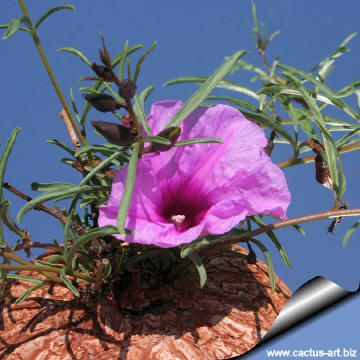 |
|
. |
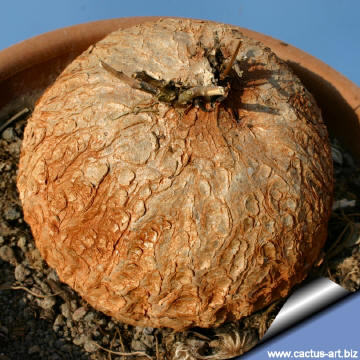 |
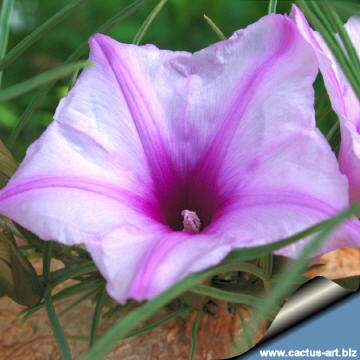 |
|
Advertising
|
|
|
|
|
Family: Convolvulaceae
Scientific name:
Ipomea bolusiana Schinz
in: Verh. Bot. Ver. Brand. Xxx: 271(1888)
Origin: Southern Africa, Madagascar, Botswana, Mozambique,
Angola; Namibia; Tanzania, Zambia, Zimbabwe
Habitat: Open woodland and savanna,
grassland with scattered shrubs, rocky and sandy soils. Altitude range
01525 m.
Etymology: Named after Harry Bolus
(1834-1911) English-born South African banker and botanist, Emigrated to
South Africa in 1850.
Synonyms:
- Ipomoea simplex Hook,
in Bot. Mag. 72: t. 4206 (1846) nom. illegit. non
Thumb.
- Ipomoea angustisecta Engl.
in Engl., Bot. Jahrb. 10: 245, t. 7, fig. A (Oct.
1888
- Ipomoea mesenterioides Hall. f.
in Bull. Herb. Boiss. 6: 544 (1898
- Ipomoea bolusiana var. abbreviata
Hall. f.
in Bull. Herb. Boiss. 7: 54 (1899).
- Ipomoea praetermissa Rendle
in Journ. Bot. 39: 56 (1901).
- Ipomoea simplex var. obtusisepala
Rendle
in Baker & Rendle in F.T.A. 4, 2: 174 (1905)
- Ipomoea bolusiana var. pinnatipartita
Verdc.
in Kirkia 6: 118 (1967).
- Ipomoea bolusiana var. elongata
Hall. F
in Bull. Herb. Boiss. 7: 54 (1899).
- Ipomoea rubro-viridis Baker 1886a
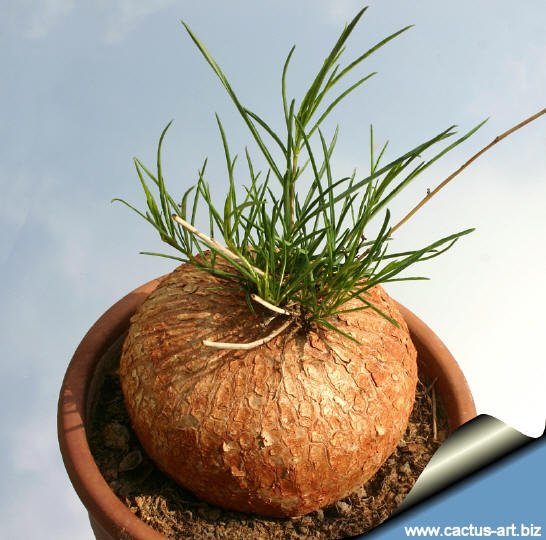
|
|
|
|
Note: Ipomoea bolusiana is often confused with the
very similar Ipomoea holubii. In fact the the caudex,
flower of both are very similar if not identical. The difference seems
to be that the leaves of the "holubii" are not needle-like
but more elliptical lanceolate, slightly larger and longer and more
spaced. And also the
viny stems are longer and flowers more numerous.
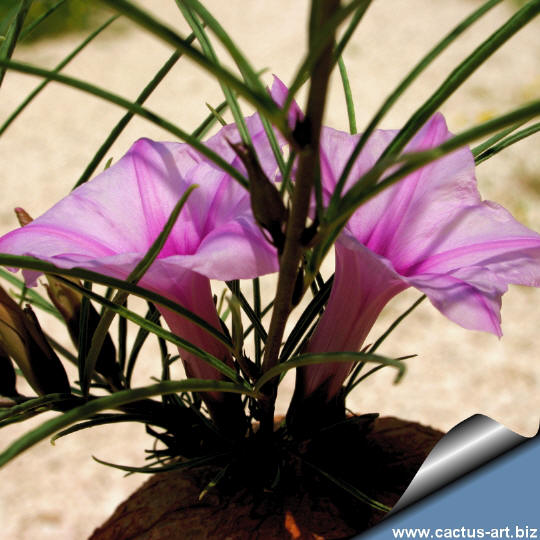
Cultivation: Ipomoea bolusiana is an old favourite
thats easy to grow and puts on a fanciful display, but it takes years
to develop and is not a plant for the impatient gardener. It needs a
well-drained soil (e.g. use a mixture for cactus + normal potting soil)
with the caudex planted largely above the soil surface. It can be
planted on the ground, it will root soon, and the chances of getting
rot are smaller this way rather than planted underground (although it
grows more slowly). It needs regular watering during the active growing
season without too much water. Let the soil become rather dry before
watering again. Stop watering gradually when the stalk dries out after
blooming in summer, or else the bulbs may rot. Start watering when the
stalk starts growing again in late winter.
Give it plenty of sun, but keep the caudex bulb shaded. Protect from
heat in summer. A clay pot is best.
USE: Ipomoea bolusiana
has an edible tuber, the small tuberous roots are roasted or
boiled.

 |
|